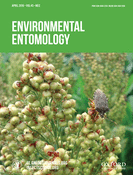-
Views
-
Cite
Cite
Sheng Lin, Liette Vasseur, Min-Sheng You, Seasonal Variability in Spider Assemblages in Traditional and Transgenic Rice Fields, Environmental Entomology, Volume 45, Issue 2, April 2016, Pages 537–546, https://doi.org/10.1093/ee/nvw002
Close - Share Icon Share
Abstract
The use of Bt transgenic rice (or Bt rice) remains controversial in several countries, including China. Risk assessments are a prerequisite to confirm the safety of Bt rice for ecosystems before a commercial release. This study was conducted to compare the responses of spider assemblages to Bt rice and nontransgenic rice. Two experiments with different locations and times were conducted, and the data were analyzed using standard diversity indices and multivariate community analysis. With both analytical approaches, spider diversity and assemblage composition were not significantly different between Bt and non transgenic rice fields. However, based on principal component analyses, temporal (seasonal) variations occurred in the composition of the spider assemblage. In this study, Bt rice had no detrimental effects on the spider assemblages, although assemblage composition and species abundance varied during the growing season. This study demonstrated an advantage in using community assemblages and repeated sampling to compare fields over a growing season because changes in the assemblages, and more specifically for some species, not always the most dominant, may vary over time. To more accurately assess the changes in composition and structure of spider assemblages through time, particularly for those species that may require a longer period to detect a response, an increase in sampling effort and longer-term experiments might be required.





